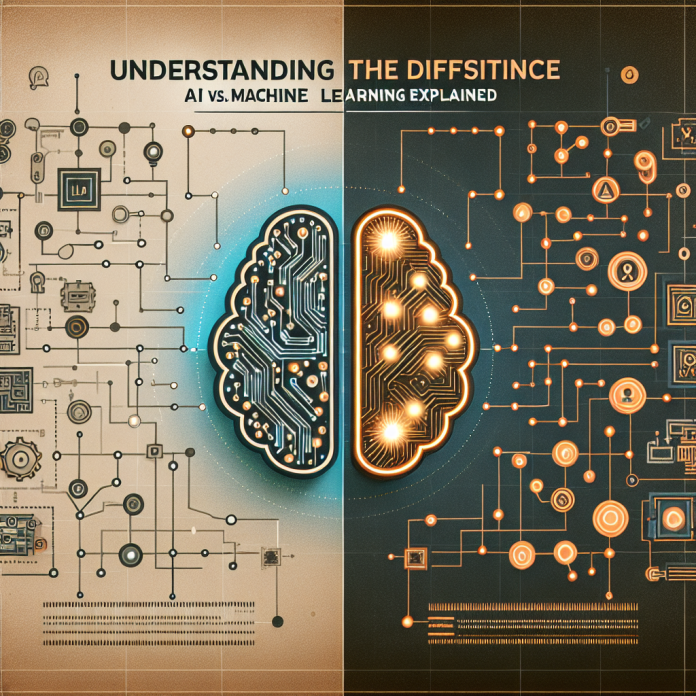Artificial Intelligence (AI) and Machine Learning (ML) are two terms that are often used interchangeably in conversations about technology and automation. However, they are not the same thing. While both AI and ML are revolutionary technologies that play a crucial role in shaping our future, it is essential to understand the key differences between the two. In this article, we will unravel the mystery behind AI vs. Machine Learning and clarify the distinction between the two concepts.
### The Basics of AI
First, let’s start by defining what Artificial Intelligence is. AI refers to the ability of machines or computer systems to perform tasks that typically require human intelligence. These tasks may include reasoning, problem-solving, perception, understanding natural language, and even decision-making. In essence, AI aims to mimic human cognitive functions and execute them in a more efficient and precise manner.
### Types of AI
There are two broad categories of AI: Narrow AI and General AI. Narrow AI, also known as Weak AI, is designed to perform a specific task or solve a particular problem. For example, virtual assistants like Siri and Alexa are examples of narrow AI systems that are programmed to understand and respond to user commands.
On the other hand, General AI, also known as Strong AI, aims to replicate human intelligence across a broad range of tasks. General AI would possess the ability to learn, adapt, and apply knowledge across various domains, similar to how humans can.
### The Role of Machine Learning
Now, let’s delve into the realm of Machine Learning. Machine Learning is a subset of AI that focuses on developing algorithms and models that enable computer systems to learn from data and improve their performance without being explicitly programmed. In simple terms, Machine Learning is all about teaching machines how to learn from experience and make predictions based on patterns and trends in data.
### Types of Machine Learning
There are three main types of Machine Learning: Supervised Learning, Unsupervised Learning, and Reinforcement Learning. In Supervised Learning, the algorithm is trained on labeled data, where the correct output is provided for each input. The model learns to map inputs to outputs based on the examples it is given.
Unsupervised Learning, on the other hand, involves training the algorithm on unlabeled data, where the model must find patterns and relationships in the data without any guidance. Clustering and association algorithms are common examples of Unsupervised Learning.
Reinforcement Learning is a type of Machine Learning where an agent learns to make decisions by interacting with its environment. The agent receives feedback in the form of rewards or penalties based on its actions, allowing it to learn through trial-and-error.
### The Distinction between AI and Machine Learning
Now that we have a clear understanding of AI and Machine Learning, let’s clarify the difference between the two concepts. AI is a broad field of study that encompasses various technologies and approaches aimed at creating machines that can perform tasks requiring human intelligence. Machine Learning, on the other hand, is a specific technique within the field of AI that focuses on developing algorithms to enable machines to learn from data.
In essence, AI is the overarching concept that encompasses Machine Learning as one of its key components. Think of AI as the umbrella term, and Machine Learning as one of the tools used to achieve AI objectives.
### Real-Life Examples
To make these concepts more tangible, let’s look at some real-life examples. Suppose you want to build a system that can predict customer purchasing behavior based on historical data. You could use Machine Learning algorithms to analyze the data, identify patterns, and make predictions about future purchases. This application of machine learning falls under the broader umbrella of AI because it involves creating a system that can perform a task traditionally associated with human intelligence.
Another example is autonomous vehicles. Self-driving cars rely on AI technologies such as computer vision, sensor fusion, and decision-making algorithms to navigate and operate safely on the road. Machine Learning plays a crucial role in training these systems to recognize and react to various objects and scenarios in real-time.
### Conclusion
In conclusion, AI and Machine Learning are two distinct concepts that are often conflated in discussions about technology and automation. AI refers to the broader field of creating machines that can perform tasks requiring human intelligence, while Machine Learning is a subset of AI that focuses on developing algorithms to enable machines to learn from data.
Understanding the difference between AI and Machine Learning is crucial for navigating the rapidly evolving landscape of technology and innovation. By grasping the fundamentals of these concepts and their applications, we can harness the power of AI and Machine Learning to drive progress and innovation in various industries.
So, the next time you hear someone mention AI or Machine Learning, remember the distinction between the two and appreciate the unique role each plays in shaping our future. The possibilities are endless when we combine the power of AI and Machine Learning to create intelligent and adaptive systems that can revolutionize how we live and work.

